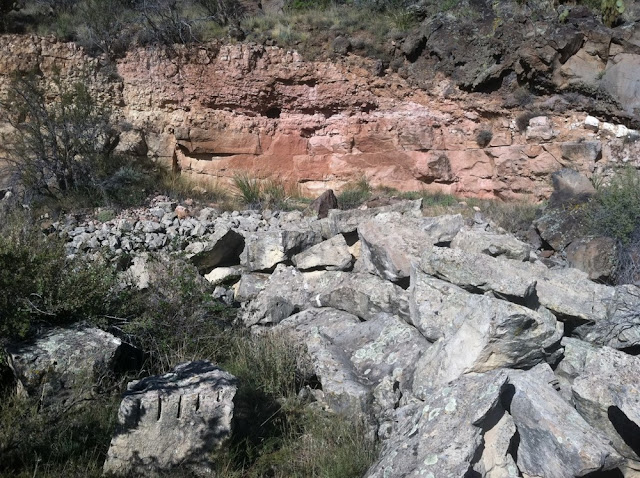The Atlantic and Pacific Railroad completed construction of their line through the Flagstaff and Williams area of Arizona in 1882. This major east-west line soon became the Atchison, Topeka, Santa Fe line. The route through northern Arizona proved to be the most difficult to construct. The bridge over Diablo Canyon was a major engineering feat. The photos below show the current bridge as well as the footings of the original bridge.
The 18 mile and 1600’ elevation difference between Williams and Ashfork necessitated the construction of a 325’ tunnel in a remote and rugged area known as Johnson Canyon. The grade through the canyon was the steepest along the entire ATSF line. Another line was constructed in 1911 to the north of this line and was used for, I believe (I can’t find the info I have on this), eastbound trains while the Johnson canyon route was used for westbounds. This 1911 section is still used as the BNSF line to Phoenix. In the late 50’s construction began to relocate both the east-west lines several miles north. These are still used by BNSF as their main line.
The above photo shows the 1911 line which is still used as the line to Phoenix.
A couple of years ago I decided to check out the abandoned Johnson Canyon line and tunnel. I didn’t have a high clearance vehicle at the time so drove in as far as I could in my car and rode my mountain bike the rest of the way. It turned out to be a great way to get to the tunnel. The grade may have been steep for a train but it was not a bit too steep to easily ride a bike on. The tunnel can be accessed by taking the Welch Rd exit off of Interstate 40 and driving a mile or so back to the east on the frontage road which is actually an old alignment of Route 66. A Forest Service road takes off pretty much due north. I don’t recall the road number offhand but this entire route is easy to determine off the Kaibab NF recreation map, a 1:24k topo map, or Google Earth. A deep drainage is soon crossed. There is an impressive geologic feature to the west of the road as it climbs out of the drainage. It is labeled as “Johnson Crater” on the topo but it is actually a sinkhole. There are several in this general area. It is clearly visible on Google Earth and is worth a look. Another half mile or so will take you to the foundations of the Welch section house. I’ve seen this on several maps also referred to as “Fairview”. There is a large trash dump adjacent to the section house. The east-west road directly adjacent to the section house foundation is the abandoned grade.
 |
| Section house foundation and a portion of the trash area. |
The road can be driven in most any type of vehicle for close to a mile or so but it soon gets really narrow because of some washouts along the grade (note: be sure to check the most current Forest Service Motor Vehicle Use map to be sure this, or any other forest road, is still open). The road is FR 9183Y. I could tell that people have driven pretty much up to the tunnel itself, which is probably two miles or so from the section house but unless you’ve got a quad or something similar, I personally wouldn’t drive all the way in. It is a beautiful walk or mountain bike ride.
The photo below shows a limestone quarry site that is visible on the slope above the grade. I’m guessing this is where the stone for the trestle footings was acquired. This is an interesting area geologically with many areas of exposed limestone with much of it covered with a layer of basalt. Another interesting feature close to the tunnel itself is a deep natural cavity in a limestone ledge below the grade. It is a bit difficult to see down into, but there appears to be some railroad related debris in it.
 |
| The remains of the guard shack are barely visible up and to the right of the west portal. |
I didn’t have a flashlight so I didn’t go into the tunnel itself. It has a curve in it so it isn’t possible to see through it. During WWII there were concerns of potential attempts to sabotage the tunnel which would have pretty effectively stopped the movement of needed materials across the country. Because of this, a U.S. Army soldier was posted at the west portal of the tunnel. I’ve seen pictures of a small wooden guard shack but I don’t recall where I found them. There is a fair number of historic photos showing the construction of the tunnel and nearby trestles. There are also numerous vintage postcards showing the tunnel.
 |
Credit: U.S. Geological Survey
Department of the Interior/USGS U.S. Geological Survey/photo by J.K. Hillers, Date unknown. |
 |
Credit: U.S. Geological Survey
Department of the Interior/USGS U.S. Geological Survey/photo by J.K. Hillers, Date unknown. |
In the summer of 2016, I decided to walk the canyon below the grade. I wanted to do this because I’ve read a few accounts of train derailments along this section of the line. I figured that there might still be pieces of train cars that had been too difficult to remove. It is a fantastic walk up the canyon and I was rewarded with finding a set of wheels. Very cool. Thankfully, these are ridiculously heavy or I'm sure that someone would have taken them. There were also quite a few large timbers that were likely to have been a part of the trestles.
 |
| The grade is halfway up the left slope. |





















